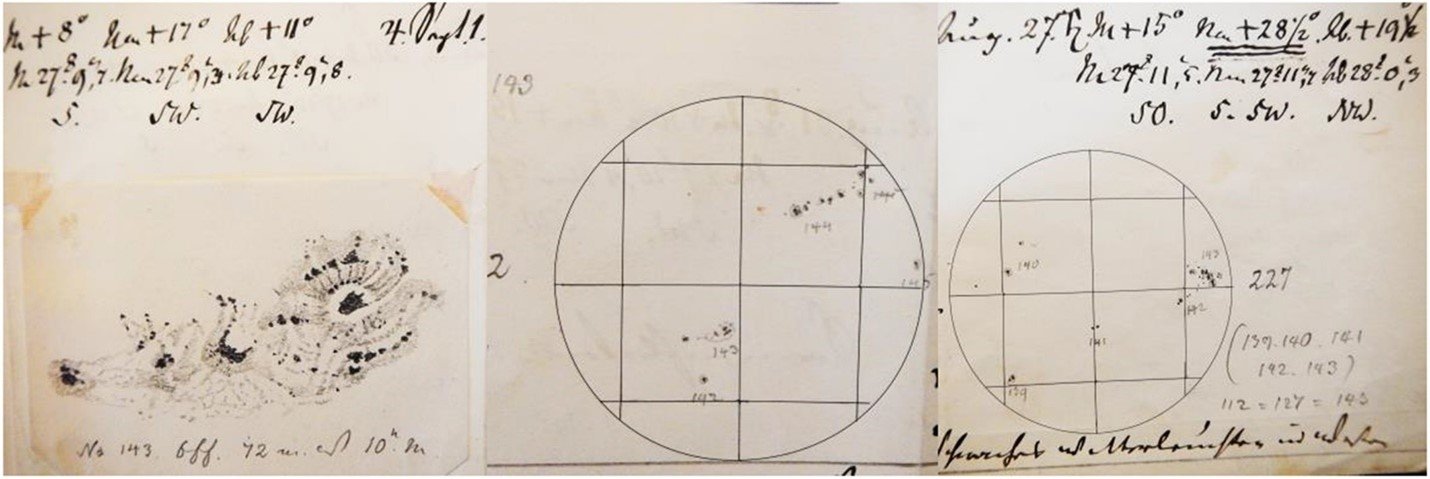SOLAR CYCLE 25 ACTIVITY REPORT NOVEMBER 04_2023
FILAMENTS ERUPTIONS AND A COMET CRASHING INTO THE SUN:. Solar activity has been at low levels for the past 24 hours. The largest solar event of the period was a C4 event observed at 0132 UTC from Region 3480 (S11E64).

● Auroral Activity

Aurora Oval Bz: -2.67 nT South

● Current Conditions at 03:30 UTC on November 04
▪︎ Geospace quiet (kp 1)
▪︎ Solar wind speed record: 472.5 km/sec (Elevated speed)
▪︎ density: 4 p/cm³ (low density)
▪︎ Interplanetary Magnetic Field (IMF)
Bt: 3.5 nT
▪︎ Thermosphere Climate Index
today: 19.48x1010 W Warm
▪︎ Neutron Counts today: - 3.6 % (Low)
▪︎ X-ray Solar Flare: C3 2238 UT Nov03
▪︎ Sunspot number: 106 (SN 113 November 03)
▪︎ Spotless Days 2023 total: 0 days (0%)
▪︎ Solar wind flowing from a coronal hole should reach Earth on Nov. 7th.
.......
SpaceWeatherlive.com
SpaceWeather.com
EarthSky.org
FILAMENTS ERUPTIONS AND A COMET CRASHING INTO THE SUN:. Solar activity has been at low levels for the past 24 hours. The largest solar event of the period was a C4 event observed at 0132 UTC from Region 3480 (S11E64).
The twisted structure of the eruption stretches over 100,000 km from end to end. It is not violent enough to throw the hot plasma (50,000K) into interplanetary space as most of it falls back on to the Sun's surface.
Note the dark filament running diagonally across the NW quadrant of the Sun. It starts to get dynamic and lifts off - it as about 700,000km long. That then causes a second slightly smaller filament to erupt to its north.
The Sun-diving comet comes in from about 5 o'clock. It is small and relatively faint so it might be best to view this full-screen. It disappears when the CME passes over it, though the CME may not have hit it directly.
There are currently 8 sunspot regions on the solar disk: AR3472, AR3473 AR3474 AR3476, AR3477, AR3478, AR3479 and new region AR3480
Total number of sunspots has decreased to 106 (36 of these are grouped into 8 active regions) NOAA forecasts for the next 24h: 90% chance for C flares, 40% chance M flares and 5% chance for X flares.
AR3474 (S18W58) has a beta-gamma magnetic field that harbors energy for M-class flares.
AR3474 (S18W58) has a beta-gamma magnetic field that harbors energy for M-class flares.
● Auroral Activity
The geomagnetic field has been at quiet levels for the past 24 hours. On November 03 Solar wind speed reached a peak of 506 km/s at 0844 UTC Total IMF reached 3 nT at 05:30 UTC
GEOMAGNETIC STORM WATCH (G2): High-latitude sky watchers should be alert for auroras this weekend when as many as three CMEs could make contact with Earth's magnetic field. The first two CMEs are mostly off-target, but they could deliver glancing blows on Nov. 4th. If they combine to form a Cannibal CME, the result could be a minor G1-class geomagnetic storm.
Of greater interest is the third CME, which left the sun yesterday:

This halo CME appears to be heading directly toward Earth. It was hurled into space by a complex eruption of magnetic filaments snaking across the sun's northern hemisphere: movie.
A NASA model of the CME suggests it will arrive on Nov. 5th between 1200 UT and 1800 UT. Its impact could add to that of the preceding two CMEs, boosting geomagnetic storms to category G2--a level that may require all three CMEs to be effective. If such a storm occurs, it could produce auroras in the USA from New York to Oregon. SpaceWeather.com
Aurora Oval Bz: -2.67 nT South
● Current Conditions at 03:30 UTC on November 04
▪︎ Geospace quiet (kp 1)
▪︎ Solar wind speed record: 472.5 km/sec (Elevated speed)
▪︎ density: 4 p/cm³ (low density)
▪︎ Interplanetary Magnetic Field (IMF)
Bt: 3.5 nT
▪︎ Thermosphere Climate Index
today: 19.48x1010 W Warm
▪︎ Neutron Counts today: - 3.6 % (Low)
▪︎ X-ray Solar Flare: C3 2238 UT Nov03
▪︎ Sunspot number: 106 (SN 113 November 03)
▪︎ Spotless Days 2023 total: 0 days (0%)
▪︎ Solar wind flowing from a coronal hole should reach Earth on Nov. 7th.
.......
SpaceWeatherlive.com
SpaceWeather.com
EarthSky.org


















